2022届高考英语二轮复习:附加疑问句课件(22张)
文档属性
| 名称 | 2022届高考英语二轮复习:附加疑问句课件(22张) |  | |
| 格式 | pptx | ||
| 文件大小 | 3.4MB | ||
| 资源类型 | 教案 | ||
| 版本资源 | 通用版 | ||
| 科目 | 英语 | ||
| 更新时间 | 2022-05-21 07:49:54 | ||
图片预览

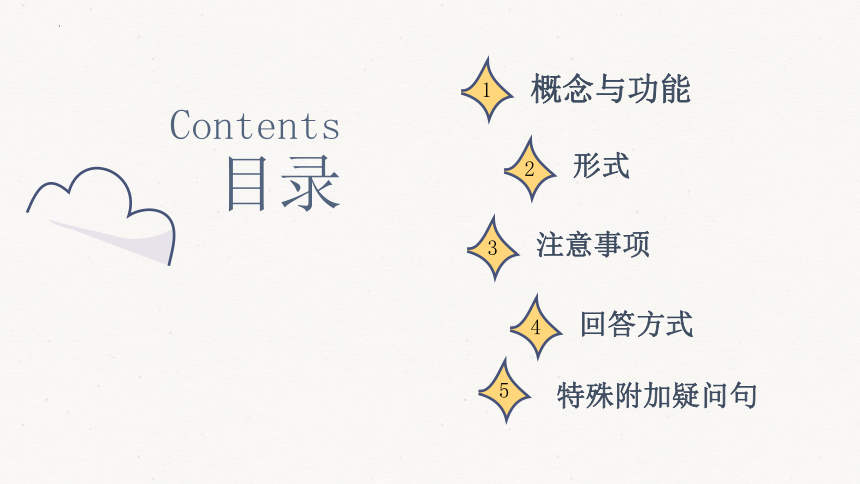
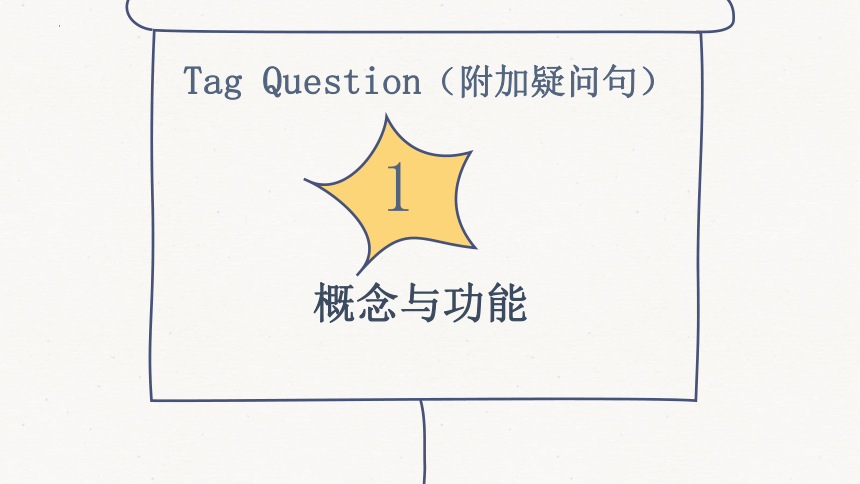
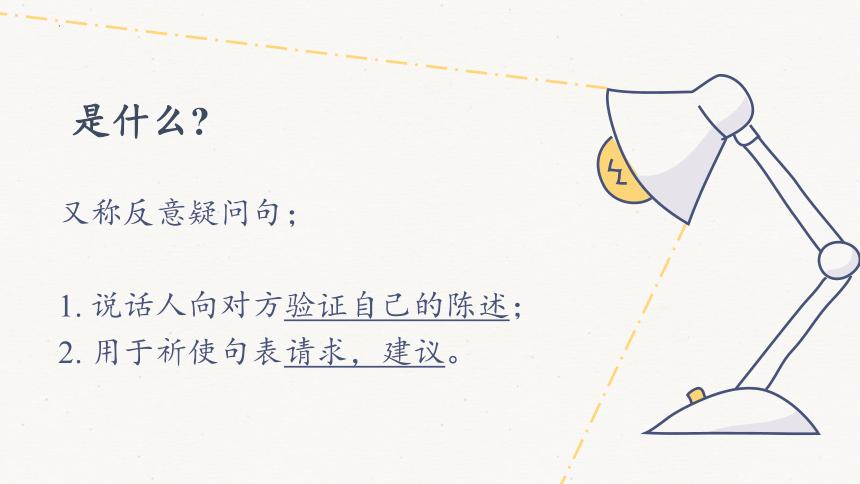

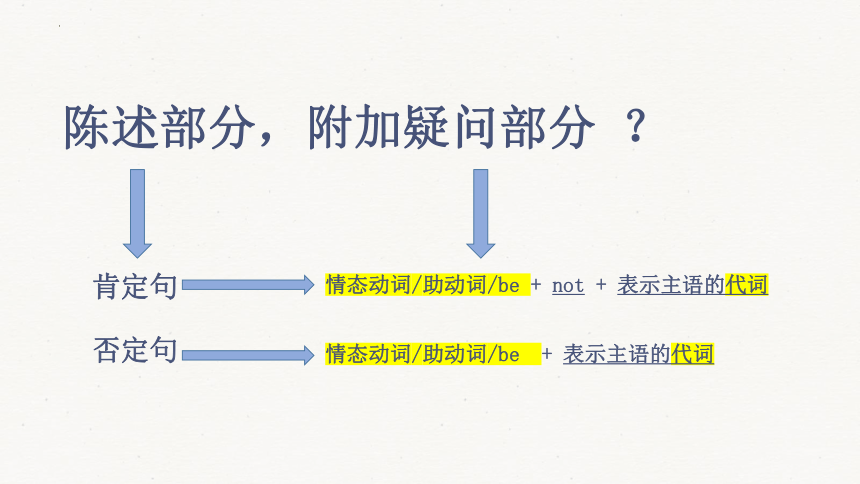
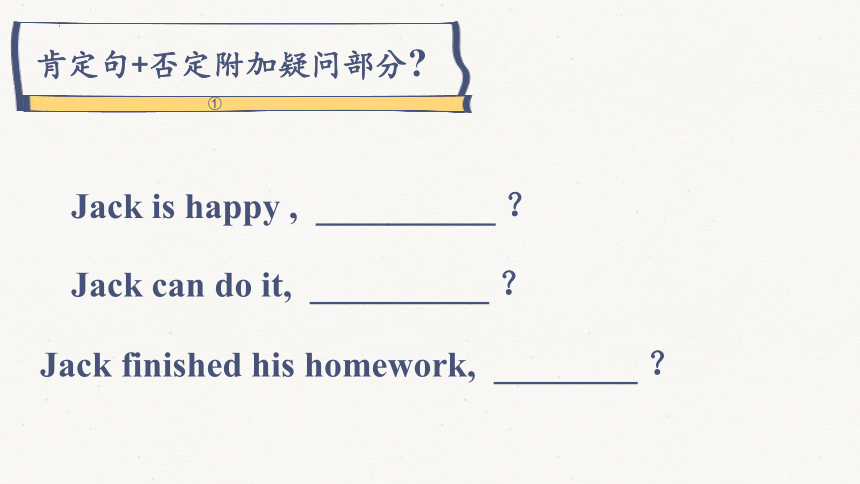
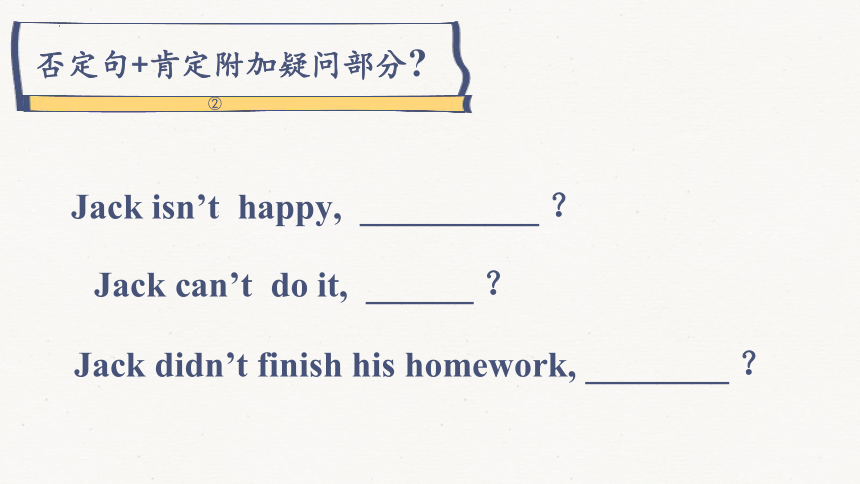
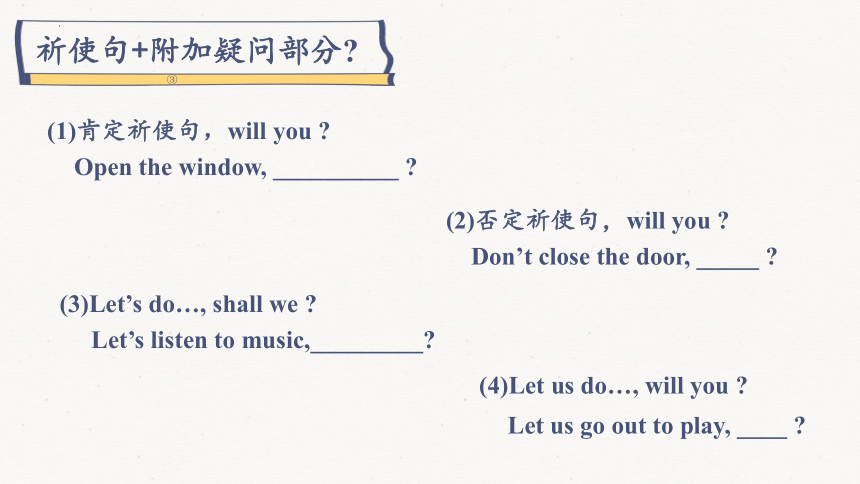
文档简介
(共22张PPT)
Tag Question
(附加疑问句)
目录
概念与功能
Contents
1
形式
2
注意事项
3
回答方式
4
5
特殊附加疑问句
概念与功能
1
Tag Question(附加疑问句)
是什么
又称反意疑问句;
1. 说话人向对方验证自己的陈述;
2. 用于祈使句表请求,建议。
形 式
2
陈述部分,附加疑问部分 ?
肯定句
情态动词/助动词/be + not + 表示主语的代词
情态动词/助动词/be + 表示主语的代词
否定句
Jack is happy , __________ ?
肯定句+否定附加疑问部分
①
Jack can do it, __________ ?
Jack finished his homework, ________ ?
否定句+肯定附加疑问部分
②
Jack isn’t happy, __________ ?
Jack can’t do it, ______ ?
Jack didn’t finish his homework, ________ ?
祈使句+附加疑问部分
③
(1)肯定祈使句,will you
Open the window, __________
(2)否定祈使句,will you
Don’t close the door, _____
(3)Let’s do…, shall we
Let’s listen to music,_________
(4)Let us do…, will you
Let us go out to play, ____
感叹句+ isn’t +表示主语的代词
④
What a smart boy, isn’t he
What a good day, ___
3
注意事项
1.陈述部分有 no, nobody, nothing, neither, little, few
never, seldom, hardly, rarely, 附加部分用肯定式。
Jack is never late, ________
Jack has few friends here, _____________
Neither of you will go to his party,________
Nobody understands his words, ____________
2. 陈述部分否定前缀的词,不影响附加部分的形式。
It is impossible, _________
He is unable to get the medal this time, ________
You dislike the game, ____________
3. 陈述部分的主语是everything,anything,nothing, something, this/that,
动词不定式,动名词,主语从句时, 附加部分的主语用it。
Everything is ready, _________
This is a new car, _________
Learning English is difficult, ________
4. 陈述部分的主语是everybody, anybody, nobody, somebody, no one,
附加部分的主语用he。
Nobody was late , __________
5. 陈述部分为there be结构时,附加部分也由there和be构成。
There is no water, ________
6. 陈述部分为主从复合句时,附加部分有两种情况。
① 陈述部分为“主(第一人称)+ think/believe/suppose+ 宾语从句”,
附加部分的主谓和从句主谓一致,而用肯定还是否定要看主句。
I believe that he can do it, _________
I don’t believe that she can do it, ___________
②陈述部分为“主(第二,三人称)+ think/believe/suppose+ 宾语从句”,
附加部分的主谓和主句主谓一致;
You think that you are funny,_________
7. 陈述部分有must时
①must表“必须,有必要”,疑问部分用needn’t.
You must leave now,___________ (你必须马上离开,不是吗?)
②mustn’t表“禁止”, 疑问部分用must.
You mustn’t laugh,____________ ( 你不准笑,知道吗?)
③must表推测时
must be/do对现在的推测
must have done对过去的推测
(陈述部分有具体的表过去的时间状语)
must have done对过去的推测
(陈述部分没有表过去的时间状语)
陈述部分
isn’t /aren’t +主语
didn’t+主语
haven’t +主语
附加部分
He must be a teacher, ________
He must have finished his homework yesterday, ________
He must have finished his homework, ________
You must be a teacher, ________
4
回答方式
He isn’t a student, is he
Yes, he is. (不,他是一个学生。)
No, he isn’t. (是,他不是一个学生。)
“前否后肯”的句子中,答语中的yes“不”;no“是”
“前肯后否”的句子中,答语中的yes“是”;no“不”
He is a student, isn’t he
Yes, he is. (是,他是一个学生。)
No, he isn’t. (不,他不是一个学生。)
5
特殊附加疑问句
1. 陈述部分为 “I am….”时,附加部分为 aren’t I .
I am late, aren’t I
2.陈述部分为 “I wish….”时,附加部分为 may I .
I wish to go with you, may I (我想和你一起去,可以吗?)
3. 陈述部分的谓语部分为固定短语had better do…(最好做),
附加部分为hadn’t +表示主语的代词。
He had better leave here,______________ (他最好离开这,是吗?)
4. 陈述部分为 There used to …“曾经有”时,
附加部分为 wasn’t(weren’t) there.
There used to be a small house, wasn’t there
There used to be three trees, weren’t there
5. 陈述部分谓语为used to do“过去常做…”时,
附加部分为didn’t + 表示主语的代词。
He used to come here, didn’t he
6.陈述部分为 “主语+ ought to do(应该)….”时,
附加部分为 oughtn’t +表主语的代词 .
He ought to know the truth, oughtn’t him (他应该知道这个事实,不是吗?)
Thanks !
Tag Question
(附加疑问句)
目录
概念与功能
Contents
1
形式
2
注意事项
3
回答方式
4
5
特殊附加疑问句
概念与功能
1
Tag Question(附加疑问句)
是什么
又称反意疑问句;
1. 说话人向对方验证自己的陈述;
2. 用于祈使句表请求,建议。
形 式
2
陈述部分,附加疑问部分 ?
肯定句
情态动词/助动词/be + not + 表示主语的代词
情态动词/助动词/be + 表示主语的代词
否定句
Jack is happy , __________ ?
肯定句+否定附加疑问部分
①
Jack can do it, __________ ?
Jack finished his homework, ________ ?
否定句+肯定附加疑问部分
②
Jack isn’t happy, __________ ?
Jack can’t do it, ______ ?
Jack didn’t finish his homework, ________ ?
祈使句+附加疑问部分
③
(1)肯定祈使句,will you
Open the window, __________
(2)否定祈使句,will you
Don’t close the door, _____
(3)Let’s do…, shall we
Let’s listen to music,_________
(4)Let us do…, will you
Let us go out to play, ____
感叹句+ isn’t +表示主语的代词
④
What a smart boy, isn’t he
What a good day, ___
3
注意事项
1.陈述部分有 no, nobody, nothing, neither, little, few
never, seldom, hardly, rarely, 附加部分用肯定式。
Jack is never late, ________
Jack has few friends here, _____________
Neither of you will go to his party,________
Nobody understands his words, ____________
2. 陈述部分否定前缀的词,不影响附加部分的形式。
It is impossible, _________
He is unable to get the medal this time, ________
You dislike the game, ____________
3. 陈述部分的主语是everything,anything,nothing, something, this/that,
动词不定式,动名词,主语从句时, 附加部分的主语用it。
Everything is ready, _________
This is a new car, _________
Learning English is difficult, ________
4. 陈述部分的主语是everybody, anybody, nobody, somebody, no one,
附加部分的主语用he。
Nobody was late , __________
5. 陈述部分为there be结构时,附加部分也由there和be构成。
There is no water, ________
6. 陈述部分为主从复合句时,附加部分有两种情况。
① 陈述部分为“主(第一人称)+ think/believe/suppose+ 宾语从句”,
附加部分的主谓和从句主谓一致,而用肯定还是否定要看主句。
I believe that he can do it, _________
I don’t believe that she can do it, ___________
②陈述部分为“主(第二,三人称)+ think/believe/suppose+ 宾语从句”,
附加部分的主谓和主句主谓一致;
You think that you are funny,_________
7. 陈述部分有must时
①must表“必须,有必要”,疑问部分用needn’t.
You must leave now,___________ (你必须马上离开,不是吗?)
②mustn’t表“禁止”, 疑问部分用must.
You mustn’t laugh,____________ ( 你不准笑,知道吗?)
③must表推测时
must be/do对现在的推测
must have done对过去的推测
(陈述部分有具体的表过去的时间状语)
must have done对过去的推测
(陈述部分没有表过去的时间状语)
陈述部分
isn’t /aren’t +主语
didn’t+主语
haven’t +主语
附加部分
He must be a teacher, ________
He must have finished his homework yesterday, ________
He must have finished his homework, ________
You must be a teacher, ________
4
回答方式
He isn’t a student, is he
Yes, he is. (不,他是一个学生。)
No, he isn’t. (是,他不是一个学生。)
“前否后肯”的句子中,答语中的yes“不”;no“是”
“前肯后否”的句子中,答语中的yes“是”;no“不”
He is a student, isn’t he
Yes, he is. (是,他是一个学生。)
No, he isn’t. (不,他不是一个学生。)
5
特殊附加疑问句
1. 陈述部分为 “I am….”时,附加部分为 aren’t I .
I am late, aren’t I
2.陈述部分为 “I wish….”时,附加部分为 may I .
I wish to go with you, may I (我想和你一起去,可以吗?)
3. 陈述部分的谓语部分为固定短语had better do…(最好做),
附加部分为hadn’t +表示主语的代词。
He had better leave here,______________ (他最好离开这,是吗?)
4. 陈述部分为 There used to …“曾经有”时,
附加部分为 wasn’t(weren’t) there.
There used to be a small house, wasn’t there
There used to be three trees, weren’t there
5. 陈述部分谓语为used to do“过去常做…”时,
附加部分为didn’t + 表示主语的代词。
He used to come here, didn’t he
6.陈述部分为 “主语+ ought to do(应该)….”时,
附加部分为 oughtn’t +表主语的代词 .
He ought to know the truth, oughtn’t him (他应该知道这个事实,不是吗?)
Thanks !
